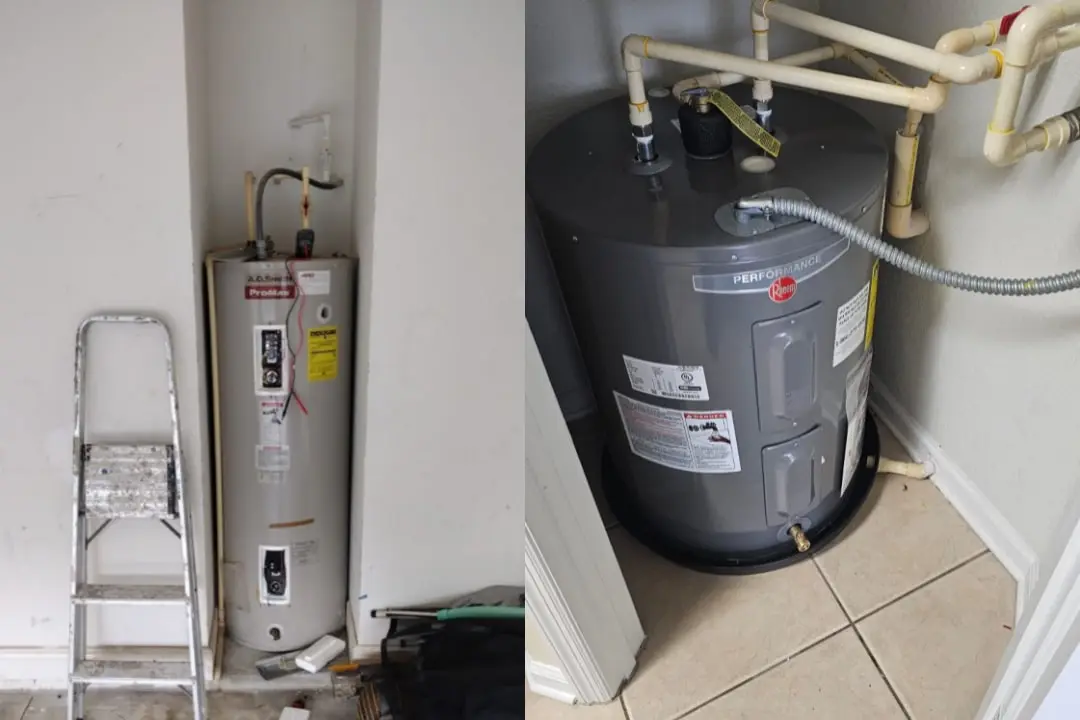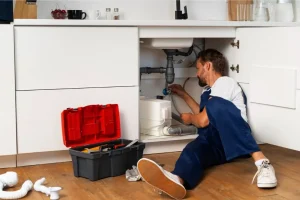Safety should be your top priority if you’re thinking about a water heater replacement or simply looking to maintain your current one. A malfunctioning water heater can throw off your daily routine by depriving you of hot water for bathing and pose a risk of burn injuries. Moreover, leaks can cause significant property damage and foster mold growth, leading to expensive repairs.
To safeguard your water heating system, it’s essential to take proactive steps such as conducting regular leak checks, installing carbon monoxide detectors, maintaining proper ventilation, and adhering to safety guidelines around the heater area.
In this post, we’ll provide valuable safety tips to protect against potential hazards associated with your home’s water heating system.
Water Heater Safety Tips & Precautions For Orlando & Kissimmee Homeowners
Here are some important water heater safety tips tailored specifically for your area, providing reassurance for you and your loved ones.
1. Choose the Correct Size Of The Water Heater
Ensuring safety and efficiency starts with choosing the right size water heater. If it’s too small, you may run out of hot water during peak times, causing inconvenience and potential safety issues. On the other hand, an oversized heater can lead to energy wastage and unnecessarily high utility bills.
To find the perfect fit for your household, take into account factors like the number of residents, their hot water usage habits, and the size of your home. Consulting with a professional can provide valuable guidance in selecting the optimal size, guaranteeing that your water heater operates efficiently and safely for years ahead.
2. Check The Operating Temperature
The operating temperature of your water heater is essential for safety. Most heaters are preset to around 120°F (49°C), which is generally safe for households.
However, setting the temperature too high increases the risk of scalding injuries, especially for children and the elderly. High temperatures can also cause mineral buildup and corrosion, shortening the heater’s lifespan.
Conversely, a temperature set too low may not meet your hot water needs. Aim for a safe and comfortable range, typically between 120°F and 140°F (49°C and 60°C), to prevent burns and ensure efficient operation. Adjusting to this range keeps your water heater safe and effective.
3. Inspect The Temperature Or Pressure Relief Valve Function
It’s important to inspect the temperature or pressure relief valve to ensure your water heater operates safely. This valve is crucial as it’s designed to release pressure or hot water from the tank if levels become dangerous, preventing potential explosions or other serious hazards.
To check its function, start by locating the valve near the top of the tank and examine it to ensure there are no leaks or corrosion. Then, carefully lift the lever on the valve to allow a small amount of water to discharge.
If water flows freely and stops when you release the lever, the valve is working properly. However, if the valve is faulty or doesn’t release water when tested, it’s imperative to have it replaced immediately by a qualified plumber.
4. Ensure The Correct Gas Pressure
Maintaining the correct gas pressure is vital for the safe operation of your gas water heater. Incorrect pressure can lead to incomplete combustion, resulting in the production of carbon monoxide, a potentially deadly gas that is colorless and odorless.
To ensure the right gas pressure, it’s important to have a qualified technician inspect and adjust the gas pressure regulator if needed. This ensures efficient fuel burning and minimizes the risk of carbon monoxide leaks.
Regular maintenance of your gas appliances, including cleaning burner ports and ensuring proper ventilation, is also crucial for safe operation and preventing carbon monoxide buildup in your home.
5. Routinely Check For Proper Electrical Supply
Start by inspecting the power cord and plug for any signs of damage or wear. Ensure that the outlet is in good condition and provides the correct voltage for your water heater. If you notice any frayed wires, exposed conductors, or loose connections, have them repaired by a qualified electrician to prevent electrical hazards.
Additionally, consider installing a ground fault circuit interrupter (GFCI) outlet near your water heater to provide an extra layer of protection against electrical shocks. Periodically testing the GFCI outlet and resetting it if necessary can help ensure continued safety.
6. Remove Fire Hazards
In addition to other safety measures, it’s crucial to eliminate fire hazards around your water heater to maintain a safe home environment. Be sure to check for any flammable materials such as paper, cardboard, or chemicals stored near the heater.
Keep the space around your water heater clear of clutter and debris to prevent accidental fires. If your water heater is situated in a utility room or garage, steer clear of storing gasoline, paints, or other combustible materials nearby. Also, ensure that the heater is securely installed on a stable surface and isn’t leaning against any walls or objects that could potentially ignite.
7. Ensure Adequate Ventilation
Proper ventilation is essential for allowing harmful gases like carbon monoxide to escape, thereby reducing the risk of carbon monoxide poisoning. Check that the area around your water heater is well-ventilated and free from obstructions.
If your water heater is situated in a confined space, such as a closet or utility room, consider installing a vent pipe to direct gases outside. Regularly inspect vents and flues for any blockages or damage, and ensure they are functioning correctly.
If you observe any signs of inadequate ventilation, such as soot buildup or a yellow flame on the burner, it’s important to contact a professional promptly to address the issue. This ensures the safety of your home and occupants.
8. Install Carbon Monoxide Detectors
Enhance safety around your water heater by installing carbon monoxide detectors. These devices are essential for alerting you to the presence of carbon monoxide gas, which can be emitted by malfunctioning water heaters and other appliances.
Ensure to place detectors near sleeping areas and on every level of your home for maximum coverage. Test the detectors regularly and replace batteries as needed to ensure they remain operational.
If a carbon monoxide alarm sounds, evacuate your home immediately and contact emergency services. By installing carbon monoxide detectors, you can protect yourself and your family from the dangers of this odorless and colorless gas.
9. Monitor For Leaks & Unusual Sounds
Monitor your water heater regularly for leaks and unusual sounds to catch potential issues early. Check around the base of the heater for any signs of water accumulation, which could indicate a leak.
Also, listen for unusual sounds such as banging, popping, or hissing, which may signal problems with the heating element or pressure buildup inside the tank.
If you notice any leaks or unusual sounds, it’s important to address them promptly to prevent further damage and ensure the safe operation of your water heater. Ignoring these warning signs could lead to costly repairs or even a dangerous malfunction.
10. Schedule Regular Maintenance Inspections
Don’t overlook the importance of scheduling regular maintenance inspections for your water heater. Hiring a professional to inspect your water heater annually can help identify potential issues early on, ensuring that your system operates safely and efficiently.
During these inspections, the technician will check for leaks, corrosion, sediment buildup, and other signs of wear and tear. They’ll also ensure that all components are functioning properly and make any necessary adjustments or repairs.
Frequently Asked Questions
What Is The Safety Control On A Water Heater?
The safety control on a water heater is typically a temperature and pressure relief valve. This valve is designed to release pressure or hot water from the tank if it reaches dangerous levels, preventing explosions or other serious hazards.
Do You Need A Water Heater Safety Tank?
A water heater safety tank, also known as a thermal expansion tank, is recommended in certain situations. It helps manage pressure fluctuations in the water heater system and reduces the risk of damage to the tank and associated plumbing. If your water heater operates in a closed system or experiences frequent temperature changes, a safety tank may be necessary.
What Is The Right Pressure In A Hot Water Heater?
The right pressure in a hot water heater typically ranges from 40 to 60 pounds per square inch (psi). This pressure is sufficient for normal operation and ensures adequate water flow throughout your plumbing system.
Does the Water Heater Increase Pressure?
Yes, a water heater can increase pressure within the plumbing system, particularly during the heating process. This pressure buildup can be managed with safety features such as temperature and pressure relief valves, as well as thermal expansion tanks.
In Closing
Keeping your home’s water heater in good shape is vital for your family’s safety and your property’s upkeep. For water heater replacement service in Orlando or Kissimmee, staying alert about potential hazards and taking preventive measures can spare you from costly repairs and provide peace of mind.
Bear in mind that investing time and effort into water heater safety today can spare you from future issues, allowing you to enjoy comfort and peace in your home for years ahead.




